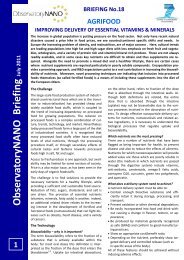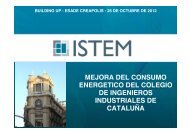Nanofillers - Improving Performance & Reducing Cost - Nanopinion
Nanofillers - Improving Performance & Reducing Cost - Nanopinion
Nanofillers - Improving Performance & Reducing Cost - Nanopinion
Create successful ePaper yourself
Turn your PDF publications into a flip-book with our unique Google optimized e-Paper software.
ObservatoryNANO Briefing September 20112NANOFILLERS ‐ IMPROVING PERFORMANCE AND REDUCING COSTA common approach is the production of threedimensionalfiller particles by either grinding, millingor precipitation techniques. In contrast, alsobottom‐up approaches have been studied wherethe filler material is incorporated as a buildingblock on the molecular level. This case can be regardedas zero‐dimensional nanofillers. In this regardinorganic‐organic hybrid materials have beeninvestigated intensively. Figure 2 gives an overviewof the different filler particle geometries.Figure 2: Different filler particle geometries.POSS moleculesPolyhedral oligomeric silsesquioxane (POSS) moleculesrepresent a comparatively new approach as abuilding block for new nanocomposite materials.The biggest advantage of using a molecular approachcan be found in a true dispersion at thenanometre level. POSS molecules can be used asreinforcing filler in plastics to increase the mechanicalstrength. They are also relevant as abrasionprotection in paints and coatings and as fireretardant material in polymers.Precipitated Calcium Carbonate (PCC)Calcium carbonate (CaCO 3 ) is by far the mostwidely used filler material in the world, particularlyas a filler in paper and plastics. Traditionally, CaCO 3is mined from natural resources (limestone andprocessed by milling techniques. The resulting materialis therefore called ground CaCO 3 (GPP). Itssynthetic counterpart is called precipitated CaCO 3(PCC) exhibiting finer particles sizes and smallerparticle size distribution. It is available in fine andultra‐fine grades whereby the latter one is sometimesreferred to as nano‐precipitated CaCO 3 . Particlessizes range from 60nm to 150nm. It is usedas filler in adhesives and sealants to adjust therheological properties and also in plastics to improvemechanical strength and durability.Fumed SilicaFumed or pyrogenic silica is a form of noncrystallinesilicon dioxide. Primary particle sizes arebetween 5‐30 nm which aggregate into larger agglomerateswhile maintaining a fairly large specificsurface area of 10‐600 m²/g. 4 Fumed silica iswidely used as anti‐caking additive and thickeningagent with thixotropic property (becomes liquidwhen stirred or shaken but return to original statewhen at rest). It is also used in paints, coatings,adhesives and sealants but also as filler in plasticsand rubber. Many different untreated and treatedgrades with varying properties are on the markettoday. Fumed silica is also used in thermal insulationmaterial such as vacuum insulation panels 5 .Precipitated SilicaPrecipitated silica is produced from aqueous sodiumsilicates precipitated with sulphuric acid. Incontrast to fumed silica precipitated silica consistsof porous particles with a primary particle size ofabout 5‐100 nm which form large agglomerates ofseveral micrometres. The specific surface area canbe as high as 200m²/g. 6 Precipitated silica is mainlyused as reinforcing filler in the rubber industry butalso as filler in plastics and sealants (silicone rubber)and adhesives (epoxy).Precipitated Barium sulphatePrecipitated barium sulphate (BaSO 4 ) is called“Blanc fixe” due to its whitening ability. It is usedas brightener or white pigment. Blanc fixe is mainlyused as filler in paints and coatings but also in plastics.The production of ultrafine or nanoprecipitatedbarium sulphate (nanoPBS) has beeninvestigated recently 7 . However, particle sizes ofBlanc fixe are generally well above the nanometrerange so is not considered as nanomaterial.Titanium DioxideTitanium dioxide (TiO 2 ) is naturally occurring inthree different forms; rutil, anatase, and brookite.Rutil is mainly used as white pigment in paints andcoatings while the anatase modification is widelyused in photocatalytic applications. TiO 2 is alsoused as filler in silicone rubber 8 and thermoplasticssuch as PVC.NanoclaysNanoclays are plate‐like nanoparticles of naturaloccurring layered silicates. Clay minerals are dividedin numerous classes such as bentonites orhectorites. Bentonites mainly consist of so calledmontmorillonites, the most widely used nanoclayin material applications today. Montmorillonitesare build up of stacked nanoscopic aluminosilicateplates each around 1nm in height and 1 µm in diameterand are used as filler in plastics. Organicallymodified montmorillonites, so called organoclays,are used to increase the flame retardancy of polymersespecially in cables; the flame propagation issignificantly reduced and no dripping of burningpolymer is observed 9 . However, aluminium trihydroxide(ATH) currently dominates the world marketfor fire protection agents.Carbon nanotubesCarbon nanotubes (CNT) have been investigatedintensively due to their unique mechanical and





